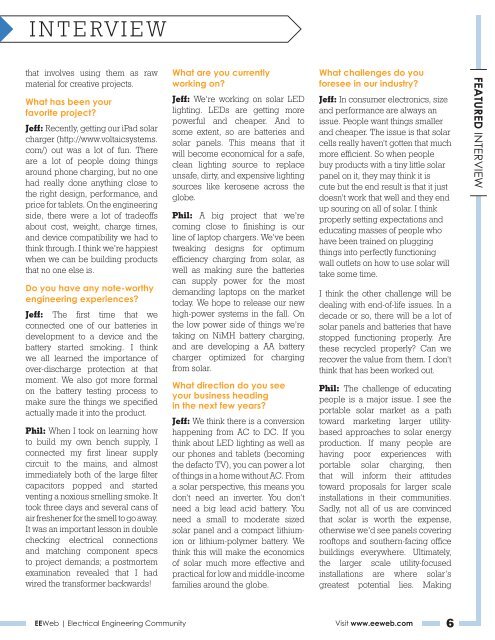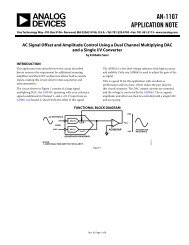EE Web PULSE
EE Web PULSE
EE Web PULSE
You also want an ePaper? Increase the reach of your titles
YUMPU automatically turns print PDFs into web optimized ePapers that Google loves.
INTERVIEW<br />
that involves using them as raw<br />
material for creative projects.<br />
What has been your<br />
favorite project?<br />
Jeff: Recently, getting our iPad solar<br />
charger (http://www.voltaicsystems.<br />
com/) out was a lot of fun. There<br />
are a lot of people doing things<br />
around phone charging, but no one<br />
had really done anything close to<br />
the right design, performance, and<br />
price for tablets. On the engineering<br />
side, there were a lot of tradeoffs<br />
about cost, weight, charge times,<br />
and device compatibility we had to<br />
think through. I think we’re happiest<br />
when we can be building products<br />
that no one else is.<br />
Do you have any note-worthy<br />
engineering experiences?<br />
Jeff: The first time that we<br />
connected one of our batteries in<br />
development to a device and the<br />
battery started smoking. I think<br />
we all learned the importance of<br />
over-discharge protection at that<br />
moment. We also got more formal<br />
on the battery testing process to<br />
make sure the things we specified<br />
actually made it into the product.<br />
Phil: When I took on learning how<br />
to build my own bench supply, I<br />
connected my first linear supply<br />
circuit to the mains, and almost<br />
immediately both of the large filter<br />
capacitors popped and started<br />
venting a noxious smelling smoke. It<br />
took three days and several cans of<br />
air freshener for the smell to go away.<br />
It was an important lesson in double<br />
checking electrical connections<br />
and matching component specs<br />
to project demands; a postmortem<br />
examination revealed that I had<br />
wired the transformer backwards!<br />
What are you currently<br />
working on?<br />
Jeff: We’re working on solar LED<br />
lighting. LEDs are getting more<br />
powerful and cheaper. And to<br />
some extent, so are batteries and<br />
solar panels. This means that it<br />
will become economical for a safe,<br />
clean lighting source to replace<br />
unsafe, dirty, and expensive lighting<br />
sources like kerosene across the<br />
globe.<br />
Phil: A big project that we’re<br />
coming close to finishing is our<br />
line of laptop chargers. We’ve been<br />
tweaking designs for optimum<br />
efficiency charging from solar, as<br />
well as making sure the batteries<br />
can supply power for the most<br />
demanding laptops on the market<br />
today. We hope to release our new<br />
high-power systems in the fall. On<br />
the low power side of things we’re<br />
taking on NiMH battery charging,<br />
and are developing a AA battery<br />
charger optimized for charging<br />
from solar.<br />
What direction do you see<br />
your business heading<br />
in the next few years?<br />
Jeff: We think there is a conversion<br />
happening from AC to DC. If you<br />
think about LED lighting as well as<br />
our phones and tablets (becoming<br />
the defacto TV), you can power a lot<br />
of things in a home without AC. From<br />
a solar perspective, this means you<br />
don’t need an inverter. You don’t<br />
need a big lead acid battery. You<br />
need a small to moderate sized<br />
solar panel and a compact lithiumion<br />
or lithium-polymer battery. We<br />
think this will make the economics<br />
of solar much more effective and<br />
practical for low and middle-income<br />
families around the globe.<br />
What challenges do you<br />
foresee in our industry?<br />
Jeff: In consumer electronics, size<br />
and performance are always an<br />
issue. People want things smaller<br />
and cheaper. The issue is that solar<br />
cells really haven’t gotten that much<br />
more efficient. So when people<br />
buy products with a tiny little solar<br />
panel on it, they may think it is<br />
cute but the end result is that it just<br />
doesn’t work that well and they end<br />
up souring on all of solar. I think<br />
properly setting expectations and<br />
educating masses of people who<br />
have been trained on plugging<br />
things into perfectly functioning<br />
wall outlets on how to use solar will<br />
take some time.<br />
I think the other challenge will be<br />
dealing with end-of-life issues. In a<br />
decade or so, there will be a lot of<br />
solar panels and batteries that have<br />
stopped functioning properly. Are<br />
these recycled properly? Can we<br />
recover the value from them. I don’t<br />
think that has been worked out.<br />
Phil: The challenge of educating<br />
people is a major issue. I see the<br />
portable solar market as a path<br />
toward marketing larger utilitybased<br />
approaches to solar energy<br />
production. If many people are<br />
having poor experiences with<br />
portable solar charging, then<br />
that will inform their attitudes<br />
toward proposals for larger scale<br />
installations in their communities.<br />
Sadly, not all of us are convinced<br />
that solar is worth the expense,<br />
otherwise we’d see panels covering<br />
rooftops and southern-facing office<br />
buildings everywhere. Ultimately,<br />
the larger scale utility-focused<br />
installations are where solar’s<br />
greatest potential lies. Making<br />
<strong>EE</strong><strong>Web</strong> | Electrical Engineering Community Visit www.eeweb.com 6<br />
FEATURED INTERVIEW















